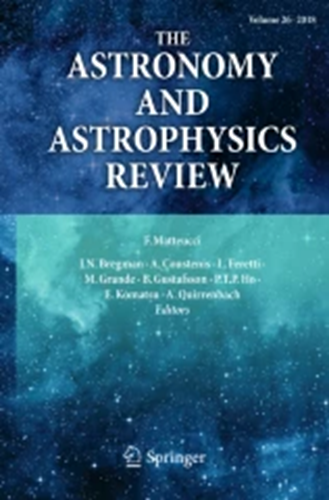The MUSE-Wide survey: Three-dimensional clustering analysis of Lyman-alpha emitters at 3.3 < z < 6
IF 26.5
1区 物理与天体物理
Q1 ASTRONOMY & ASTROPHYSICS
引用次数: 5
Abstract
We present an analysis of the spatial clustering of 695 Lyα-emitting galaxies (LAEs) in the MUSE-Wide survey. All objects have spectroscopically confirmed redshifts in the range 3.3 < z < 6. We employ the K-estimator of Adelberger et al. (2005), adapted and optimized for our sample. We also explore the standard two-point correlation function (2pcf) approach, which is however less suited for a pencil-beam survey such as ours. The results from both approaches are consistent. We parametrize the clustering properties in two ways, (i) following the standard approach of modelling the clustering signal with a power law (PL), and (ii) adopting a Halo Occupation Distribution (HOD) model of the 2-halo term. Using the K-estimator and applying HOD modeling, we infer a large-scale bias of bHOD = 2.80+0.38 −0.38 at a median redshift of the number of galaxy pairs 〈zpair〉 ' 3.82, while the best-fit power-law analysis gives bPL = 3.03+1.51 −0.52 (r0 = 3.60 +3.10 −0.90 comoving h −1Mpc and γ = 1.30+0.36 −0.45). The implied typical dark matter halo (DMH) mass is log(MDMH/[hM ]) = 11.34+0.23 −0.27 (adopting b = bHOD and assuming σ8 = 0.8). We study possible dependencies of the clustering signal on object properties by bisecting the sample into disjoint subsets, considering Lyα luminosity, UV absolute magnitude, Lyα equivalent width, and redshift as variables. We find no evidence for a strong dependence on the latter three variables but detect a suggestive trend of more luminous Lyα emitters clustering more strongly (thus residing in more massive DMHs) than their lower Lyα luminosity counterparts. We also compare our results to mock LAE catalogs based on a semi-analytic model of galaxy formation and find a stronger clustering signal than in our observed sample, driven by spikes in the simulated z-distributions. By adopting a galaxyconserving model we estimate that the Lyα-bright galaxies in the MUSE-Wide survey will typically evolve into galaxies hosted by halos of log(MDMH/[hM ]) ≈ 13.5 at redshift zero, suggesting that we observe the ancestors of present-day galaxy groups.MUSE-Wide调查:3.3 < z < 6 Lyman-alpha发射体的三维聚类分析
我们在MUSE-Wide巡天中对695个发射赖氨酸α的星系(LAEs)的空间聚类进行了分析。所有的天体都有光谱上确认的红移,范围在3.3 < z < 6。我们采用Adelberger等人(2005)的k估计器,对我们的样本进行了调整和优化。我们还探讨了标准的两点相关函数(2pcf)方法,然而,这种方法不太适合像我们这样的铅笔束测量。两种方法的结果是一致的。我们以两种方式参数化聚类属性,(i)遵循用幂律(PL)建模聚类信号的标准方法,以及(ii)采用2晕项的Halo职业分布(HOD)模型。利用k估计器并应用HOD模型,我们推断出在星系对数量< zpair > 3.82的中位红移处bHOD = 2.80+0.38−0.38的大尺度偏差,而最佳拟合幂律分析得出bPL = 3.03+1.51−0.52 (r0 = 3.60 +3.10−0.90,移动h−1Mpc和γ = 1.30+0.36−0.45)。隐含的典型暗物质晕(DMH)质量为log(MDMH/[hM]) = 11.34+0.23−0.27(采用b = bHOD, σ8 = 0.8)。我们将Lyα亮度、UV绝对星等、Lyα等效宽度和红移作为变量,通过将样本分成不相交的子集来研究聚类信号对物体属性的可能依赖性。我们没有发现强依赖于后三个变量的证据,但发现了一个暗示的趋势,即更明亮的Lyα发射体比低亮度的Lyα发射体聚集得更强(因此驻留在更大质量的DMHs中)。我们还将我们的结果与基于星系形成半解析模型的模拟LAE目录进行了比较,发现由模拟z分布的峰值驱动的聚类信号比我们观察到的样本更强。通过采用星系守恒模型,我们估计在MUSE-Wide巡天中,lyα -明亮的星系通常会演化成在红移为零时由log(MDMH/[hM])≈13.5的晕所主导的星系,这表明我们观测到了当今星系群的祖先。
本文章由计算机程序翻译,如有差异,请以英文原文为准。
求助全文
约1分钟内获得全文
求助全文
来源期刊

The Astronomy and Astrophysics Review
地学天文-天文与天体物理
CiteScore
45.00
自引率
0.80%
发文量
7
期刊介绍:
The Astronomy and Astrophysics Review is a journal that covers all areas of astronomy and astrophysics. It includes subjects related to other fields such as laboratory or particle physics, cosmic ray physics, studies in the solar system, astrobiology, instrumentation, and computational and statistical methods with specific astronomical applications. The frequency of review articles depends on the level of activity in different areas. The journal focuses on publishing review articles that are scientifically rigorous and easily comprehensible. These articles serve as a valuable resource for scientists, students, researchers, and lecturers who want to explore new or unfamiliar fields. The journal is abstracted and indexed in various databases including the Astrophysics Data System (ADS), BFI List, CNKI, CNPIEC, Current Contents/Physical, Chemical and Earth Sciences, Dimensions, EBSCO Academic Search, EI Compendex, Japanese Science and Technology, and more.
 求助内容:
求助内容: 应助结果提醒方式:
应助结果提醒方式:


